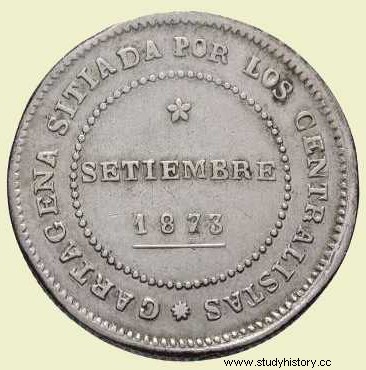Neither by occupation, nor by sale, nor by the Guano Islands Act… simply by offering Cartagena in 1873.
On February 11, 1873, the King of Spain, Amadeo de Saboya , renounced the throne with a speech that, together with the painting Duelo a garrotazos by Goya , defines us perfectly:
Two long years have passed since I girded the crown of Spain, and Spain lives in constant struggle, seeing the era of peace and happiness that I so ardently yearn for more and more distant. If the enemies of his happiness were foreigners, then, at the head of these brave and long-suffering soldiers, he would be the first to fight them; but all those who with the sword, with the pen, with the word aggravate and perpetuate the evils of the nation are Spaniards; all invoke the sweet name of the country; everyone fights and agitates for their own good, and in the heat of the combat, in the confused, thunderous and contradictory clamor of the parties, in the midst of so many and so opposing manifestations of public opinion, it is impossible to say which is the true one, and even more impossible still find remedy for sizes ills. I have searched avidly within the law and have not found it. Outside the law, those who have promised to observe it should not look for it.
The Assembly proclaimed the First Republic and elected as President the Republican Estanislao Figueras . That political turn could not do much either in the face of the serious problems faced by the bull skin (war conflicts continued in Cuba and with the Carlists, political and social instability...) and on July 12, 1873 the so-called Cantonal Revolution broke out in Cartagena. which would later spread to Valencia, Alicante, Cádiz, Málaga... This movement was in favor of a radical federalism and tried to establish a series of independent cantons (cities or confederation of cities) that would freely federate.
The revolutionaries took over the City Hall, the Civil Government, the Arsenal and appointed a Board that proclaimed the independence of the Cantón de Cartagena . In addition, he got all the ships of the Spanish fleet moored in the port (five frigates, two steamers and a corvette) to join the cause. The red flag, ensign of the canton, is hoisted at the Castillo de Galeras .
They manage to repel the first attempts of the government troops to restore order, which allows them to try to incorporate new populations into the canton and, using the fleet, they threaten the coastal populations so that they pay a revolutionary tax that allows them to finance themselves. A new newspaper is published, El Cantón Murciano, and the Cantonal Duro is minted. .
,
Cantonal Hard
The pressure of the siege begins to be suffocating and the revolutionaries contact the United States government requesting its entry into the Union and, in addition, they ask for help to maintain their independence against the centralist power of Madrid. US President, Ulysses S. Grant, promises to study the proposal but there was no time... after six months of siege, and an intense bombardment that destroyed more than half of the city, Cartagena surrendered on January 12, 1874.

Entry of government troops
Sources:Region of Murcia Digital, The Canton of Cartagena,
